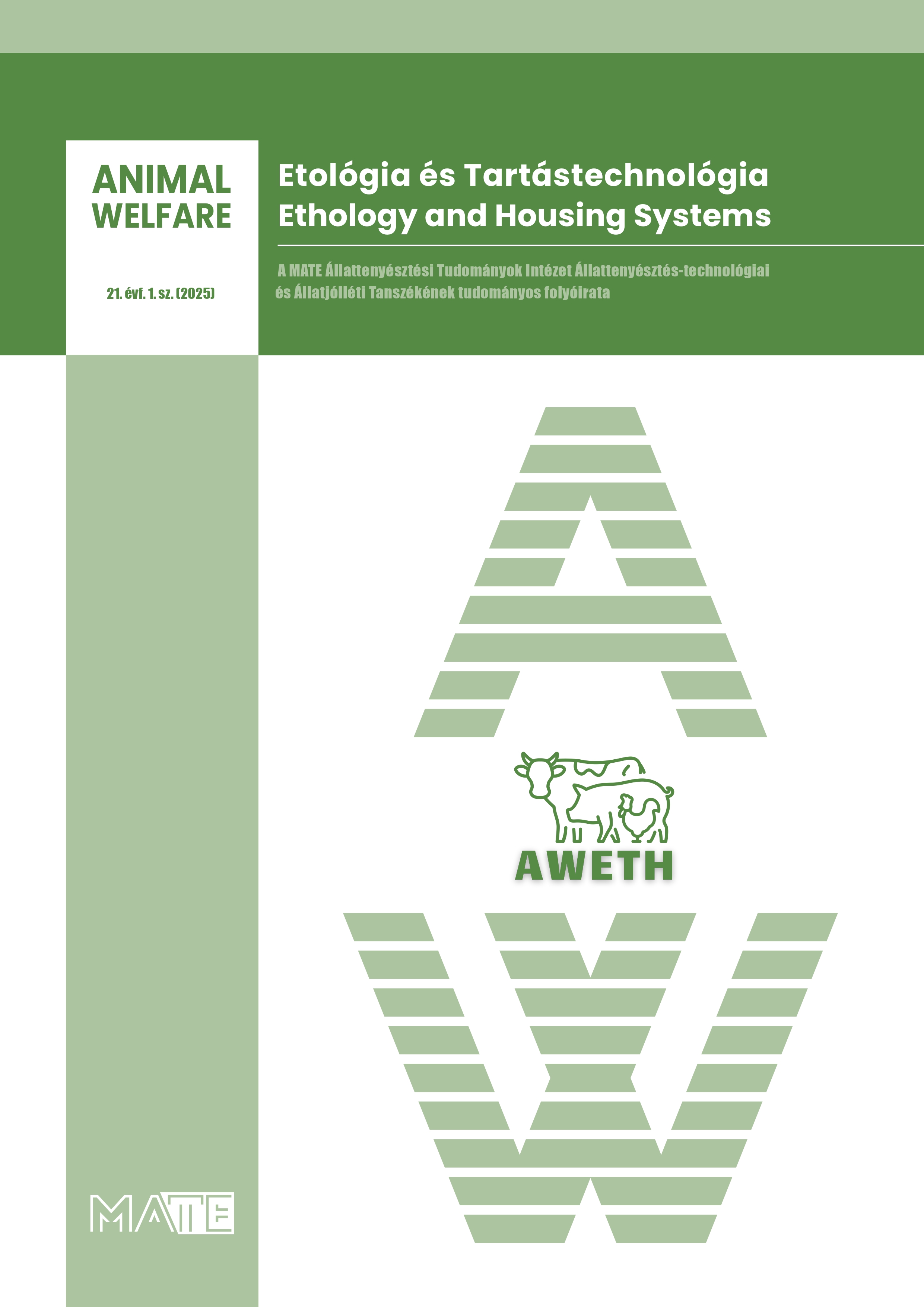A békalencse (Lemna minor), mint biológiai szűrő integrálása a hibrid afrikai harcsa (Clarias gariepinus x Heterobranchus longifilis) ivadéknevelési technológiájába
DOI:
https://doi.org/10.17205/aweth.7054Kulcsszavak:
afrikai harcsa, békalencse, akvakultúraAbsztrakt
Az emberiség állati-fehérje szükségletének kielégítésére az akvakultúrás termelés adhat megoldást. A Clarias gariepinus és a Heterobranchus longifilis harcsafajok keresztezésével előállított Heteroclarias jó növekedési eréllyel, magas technológiai és környezeti tűrőképességgel rendelkező fajhibrid. A hibridben rejlő genetikai potenciál kihasználásának érdekében intenzív takarmányozást igényel, így nevelése nagy környezeti terhelést jelenthet. Kísérletünk célja ezért az volt, hogy megvizsgáljuk, milyen hatással van az apró békalencse (Lemna minor), mint biológiai szűrő integrálása egy intenzív haltermelő rendszer vízminőségi paramétereire. Kísérletünkben két turnusban állítottunk elő Heteroclarias ivadékot félüzemi körülmények között 15 köbméteres víztérfogatú recirkulációs rendszerben (RAS). Az első turnus volt a kontroll (K), a második turnusban pedig a rendszerbe biológiai szűrőként integráltuk a Lemna minor békalencse fajt (BL). A békalencse biofilterként történő alkalmazása nem befolyásolta a halak termelési paramétereit. A vízminőségi paraméterek vizsgálata ugyanakkor azt mutatta, hogy a békalencse alkalmazása csökkentette a rendszervíz átlagos ammónia ((K) 1,26 mg/l és (BL) 0,29 mg/l) és nitrit ((K) 1,81 mg/l; (BL) 0,17 mg/l) koncentrációját a kontroll csoporthoz képest. Ennek eredményeként jelentősen csökkent a megfelelő vízminőség fenntartása érdekében végrehajtott vízcserék száma, amely nemcsak gazdasági előnyt jelent, de fenntarthatóbbá is teszi az ivadéknevelés folyamatát is.
Hivatkozások
Abdelhamid, A. M., Radwan, I. A., Mehrim, A. I. (2010): Improving the survival rate of African catfish, Clarias gariepinus. Journal of Animal and Poultry Production, 1, 409–414. https://doi.org/10.21608/jappmu.2010.86246
AKI Lehalászás Jelentés, 2024, 29(1), 30–31. https://www.aki.gov.hu/termek/lehalaszas-jelentes-2024-ev/
Almazán-Rueda, P., Schrama, J. W., Verreth, J. A. (2004). Behavioural responses under different feeding methods and light regimes of the African catfish (Clarias gariepinus) juveniles. Aquaculture., 231, 347–359. https://doi.org/10.1016/j.aquaculture.2003.11.016
Faizal, A., Sembada, A. A., Priharto, N. (2021): Production of bioethanol from four species of duckweeds (Landoltia punctata, Lemna aequinoctialis, Spirodela polyrrhiza, and Wolffia arrhiza) through optimization of saccharification process and fermentation with Saccharomyces cerevisiae. Saudi Journal of Biological Sciences, 28, 294–301. https://doi.org/10.1016/j.sjbs.2020.10.002
Hecht, T. (2013). A review of on-farm feed management practices for North African catfish (Clarias gariepinus) in sub-Saharan Africa. On-farm feeding and feed management in aquaculture, 463–479.
Hecht, T., Appelbaum, S. (1988): Observations on intraspecific aggression and coeval sibling cannibalism by larva and juvenile Clarias gariepinus (Clariidae: Pisces) under controlled conditions. Journal of Zoology, 214, 21–44. https://doi.org/10.1111/j.1469-7998.1988.tb04984.x
Iqbal, S. (1999): Duckweed aquaculture. Potentials, possibilities and limitations for combined was-tewater treatment and animal feed production in developing countries. SAn-DEC Report, 6, 99.
Körner S., Vermaat, J. E, Veenstra, S. (2003): The capacity of duckweed to treat wastewater: ecological considerations for a sound design. Journal of Environmental Quality, 32, 1583–1590. https://doi.org/10.2134/jeq2003.1583
Leng, R. A., Stambolie, J. H., Bell, R. (1995): Duckweed-a potential high-protein feed resource for domestic animals and fish. Livestock Research for Rural Development, 7, 36.
Lévai, F. Jr., Bercsényi, M., Szentgyörgyi, Á., Szabó, Z., Horváth, Z. Jr. (2024): Using duckweed (Lemna minor, L. gibba and Spirodela polyrhiza) for nutrient Recycling and water purification in an intensive catfish (Silurus glanis) production technology at farm conditions 7th Int. Conference on Duckweed Res. Bangkok
Mchunu, N., Lagerwall, G., Senzanje, A. (2018): Aquaponics in South Africa: Results of a national survey. Aquaculture Reports, 12, 12–19. https://doi.org/10.1016/j.aqrep.2018.08.001
Oron, G. (1990): Economic considerations in wastewater treatment with duckweed for effluent and nitrogen renovation. Research Journal of the Water Pollution Control Federation, 692–696.
Oron, G. (1994): Duckweed culture for wastewater renovation and biomass production. Agricultural Water Management, 26, 27–40. https://doi.org/10.1016/0378-3774(94)90022-1
Ozengin, N., Elmaci, A. (2007): Performance of Duckweed (Lemna minor L.) on different types of wastewater treatment. Journal of Environmental Biology, 28, 307–314.
Paolacci, S., Stejskal, V., Toner, D., Jansen, M. A. (2022): Integrated Multitrophic Aquaculture; Analysing Contributions of Different Biological Compartments to Nutrient Removal in a Duckweed-Based Water Remediation System. Plants, 11, 3103. https://doi.org/10.3390/plants11223103
Pienaar, A. G. (1990): A study of coeval sibling cannibalism in larval and juvenile fishes and its control under culture conditions. Masters thesis. Rhodes University, Grahamstown, South Africa.
Skjølstrup, J., Nielsen, P. H., Frier, J. O., McLean, E. (1998): Performance characteristics of fluidised bed biofilters in a novel laboratory-scale recirculation system for rainbow trout: nitrification rates, oxygen consumption and sludge collection. Aquacultural Engineering, 18, 265–276. https://doi.org/10.1016/S0144-8609(98)00037-5
Sun, Z., Guo, W., Yang, J., Zhao, X., Chen, Y., Yao, L., Hou, H. (2020): Enhanced biomass production and pollutant removal by duckweed in mixotrophic conditions. Bioresource Technology, 317, 124029. https://doi.org/10.1016/j.biortech.2020.124029
Turcios, A. E., Papenbrock, J. (2014): Sustainable treatment of aquaculture effluents - what can we learn from the past for the future? Sustainability, 6, 836–856. https://doi.org/10.3390/su6020836
Tyson, R. V., Treadwell, D. D., Simonne, E. H. (2011). Opportunities and challenges to sustainabi-lity in aquaponic systems. HortTechnology, 21(1), 6–13. https://doi.org/10.21273/HORTTECH.21.1.6
Wenzel, L. C., Berchtold, E., Palm, H.W. (2022). Effects of stocking density and grading on beha-viour, cannibalism and performance of African catfish (Clarias gariepinus) fry. Aquaculture Reports, 27, 101400. https://doi.org/10.1016/j.aqrep.2022.101400
Yahaya, N., Hamdan, N. H., Zabidi, A. R., Mohamad, A. M., Suhaimi, M. L. H., Johari, M. A. A. M., Yahja H. N., Yahya, H. (2022): Duckweed as a future food: Evidence from metabolite profile- nutritional and microbial analyses. Future Foods, 5, 100128. https://doi.org/10.1016/j.fufo.2022.100128
Yanes, A. R., Martinez, P., Ahmad, R. (2020): Towards automated aquaponics: A review on monitoring – IoT – and smart systems. Journal of Cleaner Production, 263, 121571. https://doi.org/10.1016/j.jclepro.2020.121571
Yep, B., Zheng, Y. (2019): Aquaponic trends and challenges - A review. Journal of Cleaner Production, 228, 1586–1599. https://doi.org/10.1016/j.jclepro.2019.04.290
Letöltések
Megjelent
Folyóirat szám
Rovat
License
Copyright (c) 2025 Molnár Péter István, Bak Henrietta, Ifj. Lévai Ferenc, Bársony Péter, Antalovics Máté, Fehér Milán

This work is licensed under a Creative Commons Attribution-NonCommercial-NoDerivatives 4.0 International License.
A folyóirat a nyílt hozzáférés elvei szerint működik, cikkeire ugyanakkor a Creative Commons 4.0 standard licenc alábbi típusa vonatkozik: CC-BY-NC-ND-4.0. Ennek értelmében a mű szabadon másolható, terjeszthető, bemutatható és előadható, azonban nem használható fel kereskedelmi célokra (NC), továbbá nem módosítható és nem készíthető belőle átdolgozás, származékos mű (ND). A licenc alapján a szerző vagy a jogosult által meghatározott módon fel kell tüntetni a szerző nevét és a szerzői mű címét (BY).














